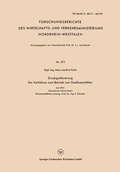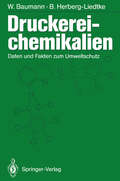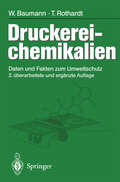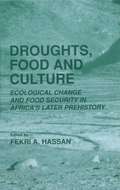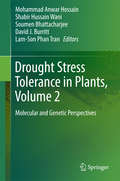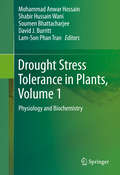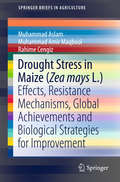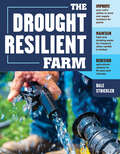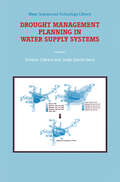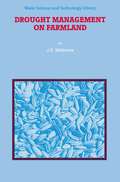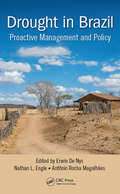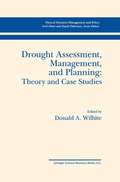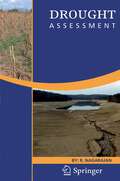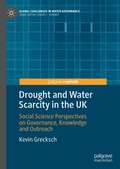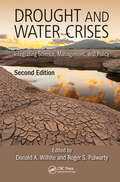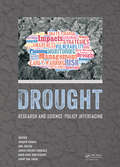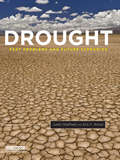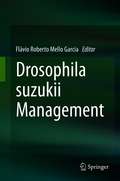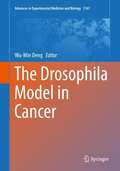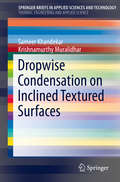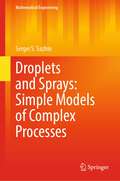- Table View
- List View
Druckgasfeuerung Ein Verfahren zum Betrieb von Gasfeuerstätten (Forschungsberichte des Wirtschafts- und Verkehrsministeriums Nordrhein-Westfalen #373)
by Hans Joachim KochDruckereichemikalien: Daten und Fakten zum Umweltschutz
by Werner Baumann Bettina Herberg-LiedtkeDas Buch gibt erstmals einen Überblick über die in der Druck- und Kopierbranche eingesetzten Chemikalien. Anwendungsbereiche, Funktionen und alle stoffspezifischen, ökologisch relevanten Informationen werden übersichtlich in Datenblättern dargestellt. Die Daten umfassen etwa 1000 wichtige Chemikalien, die in der Druckformherstellung oder in Druckfarben, Tonern und Reinigungsmitteln eingesetzt werden. Soweit möglich, sind für problematische Chemikalien Substituenten vorgeschlagen. Mit diesen Informationen wird das Buch vor allem dort sehr hilfreich sein, wo Richt- und Grenzwerte für erwartete Emissionen vorgegeben werden sollen oder wo der Drucker mehr über Inhaltstoffe und Umweltwirkungen der von ihm verwendeten Hilfsmittel wissen muß.
Druckerei-chemikalien: Daten und Fakten zum Umweltschutz 2., erweiterte und überarbeitete Auflage
by Werner Baumann Thomas RothardtDie 2., überarbeitete und ergänzte Auflage des vielbenützten Werkes gibt den aktuellen Stand derzeit eingesetzter Verfahren und Chemikalien in der Druck- und Kopierbranche wieder. Die intensiven Kooperationen des Autors z.B. mit der Druckfarbenindustrie und Anwendern bieten die Gewähr dafür, daß der neueste Stand des Wissens und der Technik präsentiert werden kann. Das Buch gibt einen Überblick über die eingesetzten Stoffe, ihren Anwendungsbereich, ihre Funktion im Druckprozess und soweit möglich, auch über ihre ökologische Relevanz. Zu jeder Chemikalie steht ein Datenblatt zur Verfügung, das alle wichtigen chemischen, physikalischen, biologischen und toxikologischen Daten enthält. Für Druckereien, Reproanstalten und Behörden bietet das Buch eine fundierte, kompakte Wissensbasis, auf der qualifizierte Entscheidungen getroffen werden können.
Droughts, Food and Culture: Ecological Change and Food Security in Africa’s Later Prehistory
by Fekri A. HassanRecent droughts in Africa and elsewhere in the world, from China to Peru, have serious implications for food security and grave consequences for local and international politics. The issues do not just concern the plight of African peoples, but also our global ecological future. Global climatic changes become manifest initially in regions that are marginal or unstable. Africa's Sahel zone is one of the most sensitive climatic regions in the world and the events that have gripped that region beginning in the 1970's were the first indicator of a significant shift in global climatic conditions. This work aims to bring archaeology with the domain on contemporary human affairs and to forge a new methodology for coping with environmental problems from an archaeological perspective. Using the later prehistory of Africa as a comparison, the utility of this methodological strategy in interpreting culture change and assessing long-term response to current, global climatic fluctuations is examined and understood.
Drought Stress Tolerance in Plants, Vol 2: Molecular and Genetic Perspectives
by Mohammad Anwar Hossain Shabir Hussain Wani Soumen Bhattacharjee David J Burritt Lam-Son Phan TranDrought is one of the most severe constraints to crop productivity worldwide, and thus it has become a major concern for global food security. Due to an increasing world population, droughts could lead to serious food shortages by 2050. The situation may worsen due to predicated climatic changes that may increase the frequency, duration and severity of droughts. Hence, there is an urgent need to improve our understanding of the complex mechanisms associated with drought tolerance and to develop modern crop varieties that are more resilient to drought. Identification of the genes responsible for drought tolerance in plants will contribute to our understanding of the molecular mechanisms that could enable crop plants to respond to drought. The discovery of novel drought related genes, the analysis of their expression patterns in response to drought, and determination of the functions these genes play in drought adaptation will provide a base to develop effective strategies to enhance the drought tolerance of crop plants. Plant breeding efforts to increase crop yields in dry environments have been slow to date mainly due to our poor understanding of the molecular and genetic mechanisms involved in how plants respond to drought. In addition, when it comes to combining favourable alleles, there are practical obstacles to developing superior high yielding genotypes fit for drought prone environments. Drought Tolerance in Plants, Vol 2: Molecular and Genetic Perspectives combines novel topical findings, regarding the major molecular and genetic events associated with drought tolerance, with contemporary crop improvement approaches. This volume is unique as it makes available for its readers not only extensive reports of existing facts and data, but also practical knowledge and overviews of state-of-the-art technologies, across the biological fields, from plant breeding using classical and molecular genetic information, to the modern omic technologies, that are now being used in drought tolerance research to breed drought-related traits into modern crop varieties. This book is useful for teachers and researchers in the fields of plant breeding, molecular biology and biotechnology.
Drought Stress Tolerance in Plants, Vol 1: Physiology and Biochemistry
by Mohammad Anwar Hossain Shabir Hussain Wani Soumen Bhattacharjee David J Burritt Lam-Son Phan TranAbiotic stress adversely affects crop production worldwide, decreasing average yields for most of the crops to 50%. Among various abiotic stresses affecting agricultural production, drought stress is considered to be the main source of yield reduction around the globe. Due to an increasing world population, drought stress will lead to a serious food shortage by 2050. The situation may become worse due to predicated global climate change that may multiply the frequency and duration and severity of such abiotic stresses. Hence, there is an urgent need to improve our understanding on complex mechanisms of drought stress tolerance and to develop modern varieties that are more resilient to drought stress. Identification of the potential novel genes responsible for drought tolerance in crop plants will contribute to understanding the molecular mechanism of crop responses to drought stress. The discovery of novel genes, the analysis of their expression patterns in response to drought stress, and the determination of their potential functions in drought stress adaptation will provide the basis of effective engineering strategies to enhance crop drought stress tolerance. Although the in-depth water stress tolerance mechanisms is still unclear, it can be to some extent explained on the basis of ion homeostasis mediated by stress adaptation effectors, toxic radical scavenging, osmolyte biosynthesis, water transport, and long distance signaling response coordination. Importantly, complete elucidation of the physiological, biochemical, and molecular mechanisms for drought stress, perception, transduction, and tolerance is still a challenge to the plant biologists. The findings presented in volume 1 call attention to the physiological and biochemical modalities of drought stress that influence crop productivity, whereas volume 2 summarizes our current understanding on the molecular and genetic mechanisms of drought stress resistance in plants.
Drought Stress in Maize: Effects, Resistance Mechanisms, Global Achievements and Biological Strategies for Improvement (SpringerBriefs in Agriculture #0)
by Muhammad Aslam Muhammad Amir Maqbool Rahime CengizThis book focuses on early germination, one of maize germplasm most important strategies for adapting to drought-induced stress. Some genotypes have the ability to adapt by either reducing water losses or by increasing water uptake. Drought tolerance is also an adaptive strategy that enables crop plants to maintain their normal physiological processes and deliver higher economical yield despite drought stress. Several processes are involved in conferring drought tolerance in maize: the accumulation of osmolytes or antioxidants, plant growth regulators, stress proteins and water channel proteins, transcription factors and signal transduction pathways. Drought is one of the most detrimental forms of abiotic stress around the world and seriously limits the productivity of agricultural crops. Maize, one of the leading cereal crops in the world, is sensitive to drought stress. Maize harvests are affected by drought stress at different growth stages in different regions. Numerous events in the life of maize crops can be affected by drought stress: germination potential, seedling growth, seedling stand establishment, overall growth and development, pollen and silk development, anthesis silking interval, pollination, and embryo, endosperm and kernel development. Though every maize genotype has the ability to avoid or withstand drought stress, there is a concrete need to improve the level of adaptability to drought stress to address the global issue of food security. The most common biological strategies for improving drought stress resistance include screening available maize germplasm for drought tolerance, conventional breeding strategies, and marker-assisted and genomic-assisted breeding and development of transgenic maize. As a comprehensive understanding of the effects of drought stress, adaptive strategies and potential breeding tools is the prerequisite for any sound breeding plan, this brief addresses these aspects.
The Drought-Resilient Farm: Improve Your Soil's Ability to Hold and Supply Moisture for Plants; Maintain Feed and Drinking Water for Livestock when Rainfall Is Limited; Redesign Agricultural Systems to Fit Semi-arid Climates
by Dale StricklerThis in-depth practical guide shows farmers, ranchers, and gardeners how to reduce the impact of less-than-optimal rainfall on crops and livestock with innovative, yet simple techniques for enhancing the water retention of soil and developing a drought management plan.
Drought Management Planning in Water Supply Systems: Proceedings from the UIMP International Course held in Valencia, December 1997 (Water Science and Technology Library #32)
by JorgeGarcía-Serra EnriqueCabreraDuring the past decade many countries in the world have experienced droughts, with severe impacts on water urban supply systems. Because droughts are natural phenomena, water utilities must design and implement drought management plans. This topic was selected for the International Course on Drought Management Planning in Water Supply Systems, which took place in Valencia, Spain, on 9-12 December 1997, and was hosted by the Universidad Internacional Menéndez y Pelayo (UIMP). The contributions in this book have been carefully selected and presented in four sections: Introduction Water Supply Systems Modernization Drought Management in an Urban Context Practical Cases (Israel, USA, Italy, Spain) To achieve a well-balanced approach, authors were invited from academia as well as from consultancies and water utilities, and have wide experience in the subject. The book is mainly aimed at water supply engineers, working in utilities and consultancies.
Drought Management on Farmland (Water Science and Technology Library #35)
by Joan Sydney WhitmoreAt last, integrated management of drought on farms is dealt with in one comprehensive book. Although drought is a highly variable, near-universal natural phenomenon which has repercussions on a country's water and food supplies and many other sectors of the economy, there are many ways of avoiding, resisting and mitigating the effects of drought. Pro-active preparedness entails using the principles of risk management to upgrade the drought resistance of a farm systematically, and to have auxiliary contingency plans at the ready for use during unusually long droughts. The book provides tools for these strategies as it covers the management of water, soils, crops, rangeland, fodder and livestock, and many other drought-related topics. Audience: This book will be an important source of information for university and college staff and students in agricultural sciences, water and land use, environmental management, geography and risk management, and also farmers, agricultural advisors and policy makers.
Drought in Brazil: Proactive Management and Policy (Drought and Water Crises)
by Erwin De Nys, Nathan L. Engle & Antônio Rocha MagalhãesDrought is a slow-onset natural hazard that is often referred to as a creeping phenomenon. The challenge of monitoring drought’s onset and evolution, and identifying its termination or end is one that scientists, natural resource managers, and decision makers have been struggling with for decades. However, drought management must be aimed at reducing the risks of future drought events on economies, the environment, and the social fabric of regions. As with many countries, droughts are often managed as a crisis in Brazil, rather than events for which officials and communities proactively prepare. Although droughts are not new to Brazil, the recent spate of droughts in the poverty stricken semi-arid Northeast and the industrial hub of São Paulo in the Southeast has forced the country to think more seriously about finally changing its drought policies and management approaches. The book is told through the perspectives of the ministers and secretaries, state policy and technical officials, civil society organizations, and development practitioners that helped to facilitate the shift in paradigm in Brazil from crisis management and towards proactive management of droughts. It is written in a style that is appealing to both technical and non-technical audiences, and aims to provide a framework and lessons for other countries to consider when embarking upon similar efforts to improve their own drought policy and management systems.
Drought in Brazil: Proactive Management and Policy (Drought and Water Crises)
by Erwin De Nys Nathan Engle Antônio Rocha MagalhãesDrought is a slow-onset natural hazard that is often referred to as a creeping phenomenon. The challenge of monitoring drought’s onset and evolution, and identifying its termination or end is one that scientists, natural resource managers, and decision makers have been struggling with for decades. However, drought management must be aimed at reducing the risks of future drought events on economies, the environment, and the social fabric of regions. As with many countries, droughts are often managed as a crisis in Brazil, rather than events for which officials and communities proactively prepare. Although droughts are not new to Brazil, the recent spate of droughts in the poverty stricken semi-arid Northeast and the industrial hub of São Paulo in the Southeast has forced the country to think more seriously about finally changing its drought policies and management approaches. The book is told through the perspectives of the ministers and secretaries, state policy and technical officials, civil society organizations, and development practitioners that helped to facilitate the shift in paradigm in Brazil from crisis management and towards proactive management of droughts. It is written in a style that is appealing to both technical and non-technical audiences, and aims to provide a framework and lessons for other countries to consider when embarking upon similar efforts to improve their own drought policy and management systems.
Drought Assessment, Management, and Planning: Theory and Case Studies (Natural Resource Management and Policy #2)
by Donald A. WilhiteDrought is an insidious hazard of nature. It originates from a deficiency of precipitation that results in a water shortage for some activity or some group. Africa has suffered the most dramatic impacts from drought during the past several decades the recent droughts in the southern and eastern portions of the continent are testimony to that fact. However, the vulnerability of all nations to extended periods of water shortage has been underscored again and again during this same time period. In the past decade alone, droughts have occurred with considerable frequency and severity in most of the developed and developing world. Significant parts of North and South America, Australia, Europe, and Asia have been plagued recently by extended periods of severe drought, often resulting in far-reaching economic, social, and environmental consequences. In the western United States, for example, vast areas are facing the prospects of a sixth or seventh consecutive year of drought in 1993. Concern by members ofthe scientific and policy communities about the inability of governments to respond in an effective and timely manner to drought and its associated impacts exists worldwide. Numerous "calls for action" for improved drought planning and management have been issued by national governments, professional organizations, intergovernmental organizations, nongovernmental organizations, and others. The United Nations' International Decade for Natural Disaster Reduction (lDNDR) is yet another example of an international call for action to reduce the impacts that result from drought and other natural hazards.
Drought Assessment
by R. NagarajanInformation-based decision-making during drought, often brings out some of the excellent practices that are prevalent in society / individuals. This book is designed to provide information on the drought process, meteorological, hydrological, agriculture, socio-economic aspects and available technologies such as satellite remote sensing data analysis and Geographical Information system for assessment. Assessment procedures utilising the various parameters of importance from various sources for micro level management that would enhance the effectiveness of management practice are dealt in detail. Resource availability and affected group determine the relief assistance for the present event and information that would help them in their realisation and preparedness for the forthcoming years by select countries is highlighted. This would help in the formulation of schemes for event mitigation and area development plans. The readers would gain complete knowledge on drought. This book is expected to act as a guide in preparing people as effective natural resource utilizationist under drought situations.
Drought and Water Scarcity in the UK: Social Science Perspectives on Governance, Knowledge and Outreach (Global Challenges in Water Governance)
by Kevin GreckschThis book presents a social science perspective on drought and water scarcity in the UK. It puts forward a narrative of how different stakeholders manage drought and water scarcity, how they generate and manage knowledge and how power relationships between stakeholders shape drought and water scarcity management. The book begins with an analysis and critique of all water resources management plans produced by English and Welsh water supply companies for the period 2014-2019 and introduces a novel typology for drought management options. It then moves on to discuss the effect of drought and water scarcity on businesses and production processes as well as how knowledge about drought and water scarcity is generated, by whom and for what purpose. Ultimately the book argues for the urgent need to engage people in the UK about water issues and offers a novel perspective on how to communicate and engage with drought research.
Drought and Water Crises: Integrating Science, Management, and Policy, Second Edition (Drought and Water Crises)
by Donald Wilhite Roger S. PulwartyOver the past decade there have been extraordinary advances towards drought risk reduction with the development of new water-conserving technologies, and new tools for planning, vulnerability and impact assessment, mitigation, and policy. Drought and Water Crises: Integrating Science, Management, and Policy, Second Edition comprehensively captures this evolving progress as it discusses drought management in the light of present risks, global climate change and public policy actions. This new edition emphasizes the paradigm shift from managing disasters to managing risk, reflecting the global emphasis that has evolved in recent years, a new focus that shines light on preparedness strategies and the tools and methods that are essential in drought risk reduction. The book provides additional relevant case studies that integrate this new approach and discusses examples applied in both developed and developing countries.
Drought and Water Crises: Integrating Science, Management, and Policy, Second Edition (Drought and Water Crises)
by Donald Wilhite Roger S. PulwartyOver the past decade there have been extraordinary advances towards drought risk reduction with the development of new water-conserving technologies, and new tools for planning, vulnerability and impact assessment, mitigation, and policy. Drought and Water Crises: Integrating Science, Management, and Policy, Second Edition comprehensively captures this evolving progress as it discusses drought management in the light of present risks, global climate change and public policy actions. This new edition emphasizes the paradigm shift from managing disasters to managing risk, reflecting the global emphasis that has evolved in recent years, a new focus that shines light on preparedness strategies and the tools and methods that are essential in drought risk reduction. The book provides additional relevant case studies that integrate this new approach and discusses examples applied in both developed and developing countries.
Drought: Research And Science-policy Interfacing
by Joaquín Andreu David Haro-Monteagudo Javier Paredes-Arquiola Abel Solera Henny A. J. Van LanenDroughts occur in arid and semi-arid areas of the world, but also in humid areas, and can develop over short periods (flash drought) or longer periods (seasons/decades). Even though progress has been made, it remains difficult to adequately characterize, monitor, forecast and manage droughts, due to their multi-faceted nature.Usually, drought does
Drought: Past Problems and Future Scenarios
by Justin Sheffield Eric F. WoodDrought is one of the likely consequences of climate change in many regions of the world. Together with an increased demand for water resources to supply the world's growing population, it represents a potentially disastrous threat to water supplies, agriculture and food production, leading to famine and environmental degradation. Yet predicting drought is fraught with difficulty. The aim of this book is to provide a review of the historical occurrence of global drought, particularly during the 20th century and assess the likely potential changes over the 21st century under climate change. This includes documentation of the occurrence and impacts of major 20th century drought events and analysis of the contributing climatic and environmental factors that act to force, prolong and dissipate drought. Contemporary drought is placed in the context of climate variability since the last ice age, including the many severe and lengthy drought events that contributed to the demise of great civilizations, the disappearance of lakes and rivers, and the conversion of forests to deserts. The authors discuss the developing field of drought monitoring and seasonal forecasting and describe how this is vital for identifying emerging droughts and for providing timely warning to help reduce the impacts. The book provides a broad overview of large scale drought, from historic events such as the US Dust Bowl and African Sahel, and places this in the context of climate variability and change. The work is soundly based on detailed research that has looked at drought occurrence over the 20th century, global drought monitoring, modelling and seasonal prediction, and future projections from climate models.
Drought: Past Problems and Future Scenarios
by Justin Sheffield Eric F. WoodDrought is one of the likely consequences of climate change in many regions of the world. Together with an increased demand for water resources to supply the world's growing population, it represents a potentially disastrous threat to water supplies, agriculture and food production, leading to famine and environmental degradation. Yet predicting drought is fraught with difficulty. The aim of this book is to provide a review of the historical occurrence of global drought, particularly during the 20th century and assess the likely potential changes over the 21st century under climate change. This includes documentation of the occurrence and impacts of major 20th century drought events and analysis of the contributing climatic and environmental factors that act to force, prolong and dissipate drought. Contemporary drought is placed in the context of climate variability since the last ice age, including the many severe and lengthy drought events that contributed to the demise of great civilizations, the disappearance of lakes and rivers, and the conversion of forests to deserts. The authors discuss the developing field of drought monitoring and seasonal forecasting and describe how this is vital for identifying emerging droughts and for providing timely warning to help reduce the impacts. The book provides a broad overview of large scale drought, from historic events such as the US Dust Bowl and African Sahel, and places this in the context of climate variability and change. The work is soundly based on detailed research that has looked at drought occurrence over the 20th century, global drought monitoring, modelling and seasonal prediction, and future projections from climate models.
Drosophila suzukii Management
by Flávio Roberto Mello GarciaDrosophila suzukii (Matsumura) (Diptera: Drosophilidae), the spotted wing drosophila (SWD), is the most important pest affecting berry crop production worldwide. The global fresh fruit trade, coupled with the ability of the larvae to hide inside the fruit undetected until after transportation, facilitate their distribution. SWD is native to Asia, but is increasingly found in other regions: occurrences have been recorded in the Americas and Europe, and Africa, and the insects have the potential to adapt and become established in Oceania. Gathering the experiences of leading scientists in the management of D. suzukii around the globe, the book addresses D. suzukii monitoring; biological, chemical and cultural control; sterile insect technique (SIT); integrated pest management (IPM), and other control methods. It also discusses the use of drones, GPS, biotechnology, telemetry and other technological tools to make the management of this pest more efficient and accurate. As such, it is a valuable resource for scientists, professionals and students.
The Drosophila Model in Cancer (Advances in Experimental Medicine and Biology #1167)
by Wu-Min DengThis volume provides a series of review articles that capture the advances in using the fruit fly, Drosophila melanogaster, model system to address a wide range of cancer-related topics. Articles in this book provide case studies that shed light on the intricate cellular and molecular mechanisms underlying tumor formation and progression. Readers will discover the beauty of the fly model’s genetic simplicity and the vast arsenal of powerful genetic tools enabling its efficient and adaptable use. This model organism has provided a unique opportunity to address questions regarding cancer initiation and development that would be extremely challenging in other model systems. This book provides a useful resource for a researcher who wishes to learn about and apply the Drosophila model to tackle fundamental questions in cancer biology, and to find new ways to fight against this devastating disease.
Dropwise Condensation on Inclined Textured Surfaces (SpringerBriefs in Applied Sciences and Technology)
by Sameer Khandekar Krishnamurthy MuralidharDropwise Condensation on Textured Surfaces presents a holistic framework for understanding dropwise condensation through mathematical modeling and meaningful experiments. The book presents a review of the subject required to build up models as well as to design experiments. Emphasis is placed on the effect of physical and chemical texturing and their effect on the bulk transport phenomena. Application of the model to metal vapor condensation is of special interest. The unique behavior of liquid metals, with their low Prandtl number and high surface tension, is also discussed. The model predicts instantaneous drop size distribution for a given level of substrate subcooling and derives local as well as spatio-temporally averaged heat transfer rates and wall shear stress.
Droplets and Sprays: Simple Models of Complex Processes (Mathematical Engineering)
by Sergei S. SazhinThis book acts as a guide to simple models that describe some of the complex fluid dynamics, heat/mass transfer and combustion processes in droplets and sprays. Attention is focused mainly on the use of classical hydrodynamics, and a combination of kinetic and hydrodynamic models, to analyse the heating and evaporation of mono- and multi-component droplets. The models were developed for cases when small and large numbers of components are present in droplets. Some of these models are used for the prediction of time to puffing/micro-explosion of composite water/fuel droplets — processes that are widely used in combustion devices to stimulate disintegration of relatively large droplets into smaller ones. The predictions of numerical codes based on these models are validated against experimental results where possible. In most of the models, droplets are assumed to be spherical; some preliminary results of the generalisation of these models to the case of non-spherical droplets, approximating them as spheroids, are presented.
